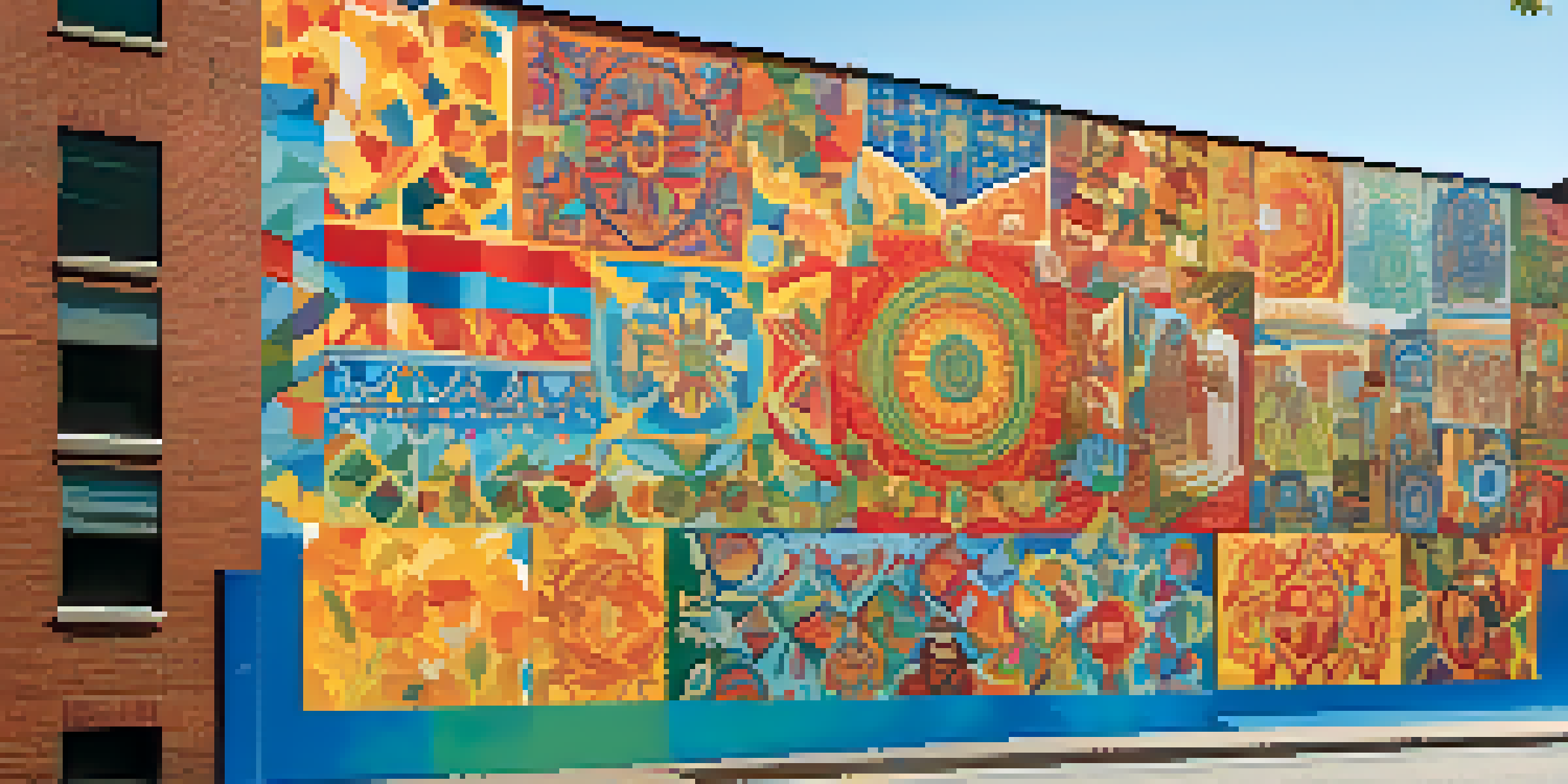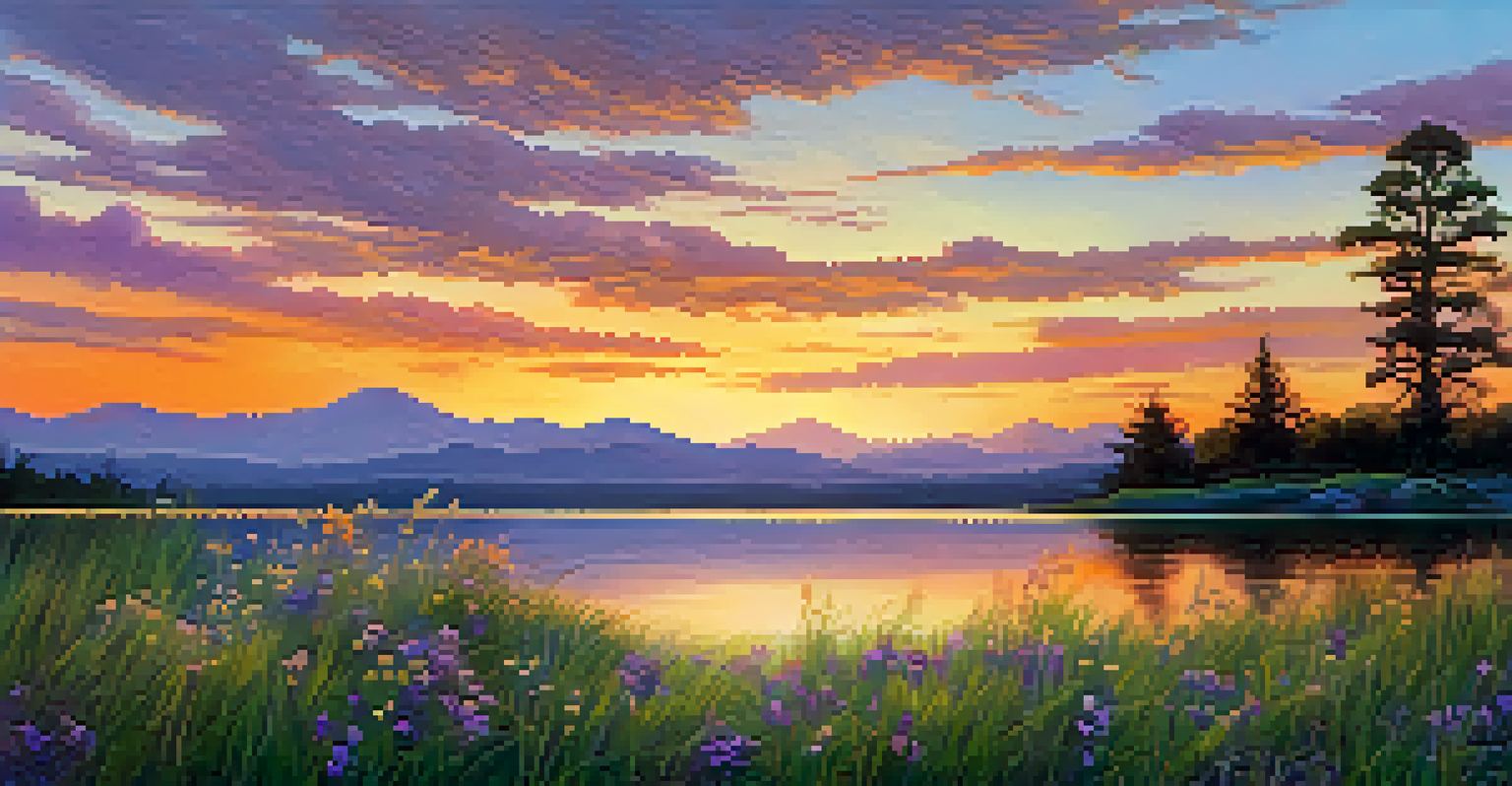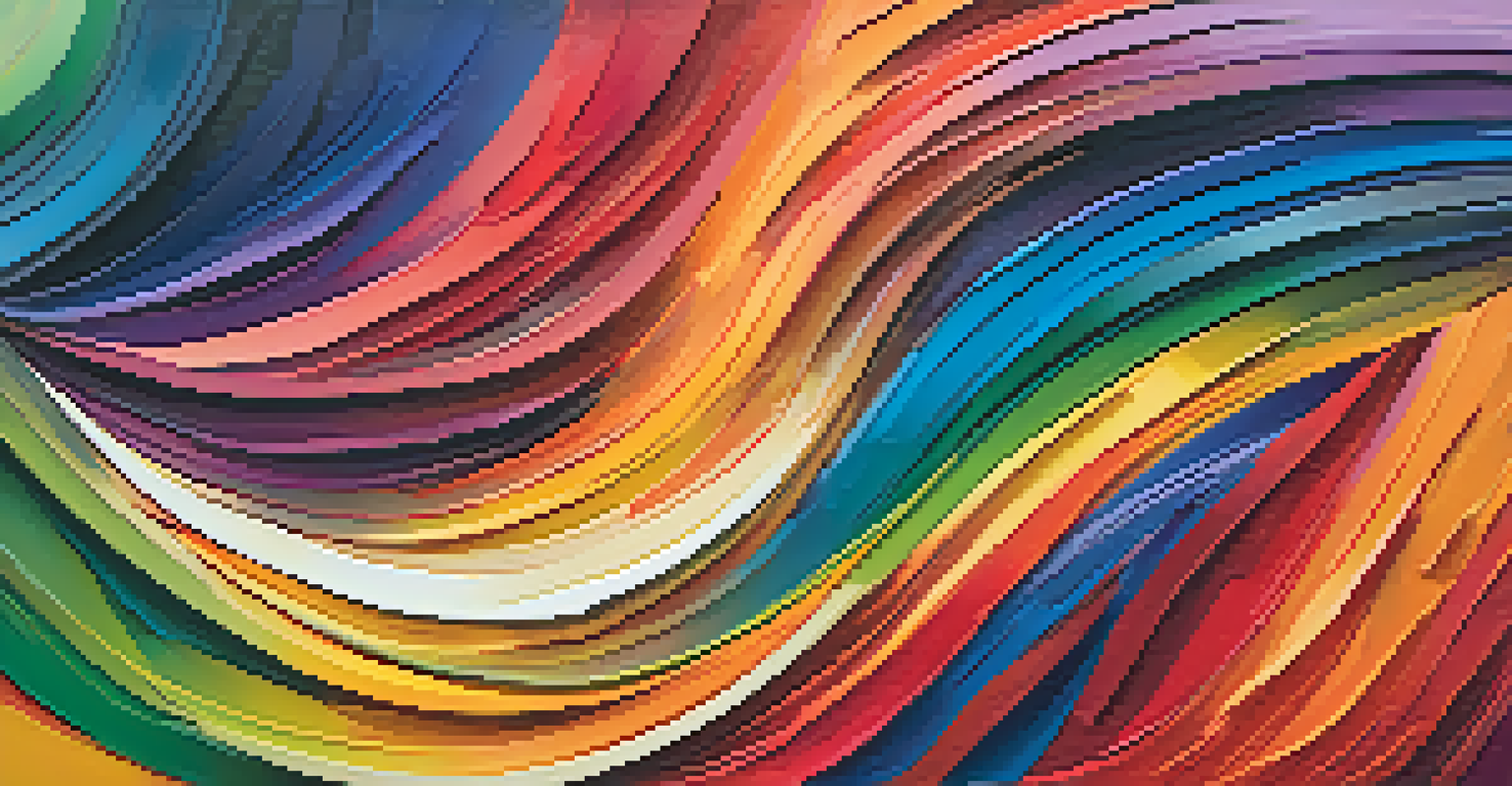Color Trends in Contemporary Art: Influences and Impacts

The Evolution of Color in Art: A Brief Overview
Color has always played a pivotal role in art, serving as a powerful tool for expression. From the bold hues of the Impressionists to the muted tones of the Minimalists, artists have continually pushed the boundaries of color usage. In contemporary art, color is not merely aesthetic; it carries emotional and symbolic weight, influencing how viewers perceive a piece. This evolution reflects broader cultural shifts, making color a fascinating lens through which to explore artistic movements.
Color is the keyboard, the eyes are the harmonies, the soul is the piano with many strings.
In the 20th century, color theories emerged, with artists like Wassily Kandinsky experimenting with color psychology. This approach deepened our understanding of how colors evoke emotions and provoke thoughts. Today's artists often draw on these historical insights, blending them with modern techniques and technologies to create dynamic visual experiences. As we explore various influences on color trends, it's essential to recognize this rich history that shapes contemporary practices.
Moreover, the digital age has transformed how colors are perceived and utilized in art. With digital tools, artists can manipulate color in ways previously unimaginable, allowing for greater experimentation. This accessibility has democratized color use, leading to a burst of innovative styles and palettes that reflect current societal themes and personal narratives.
Cultural Influences on Contemporary Color Choices
Culture plays a significant role in shaping color preferences and trends in contemporary art. For example, the vibrant colors of African textiles often inspire Western artists, highlighting a rich tapestry of cultural exchange. This cross-pollination not only influences individual artists but also helps to create broader color movements that resonate across communities. By embracing diverse cultural palettes, artists are able to create works that are more inclusive and reflective of a global society.

Moreover, social issues such as climate change and political unrest have led artists to adopt specific color schemes that evoke urgency and awareness. Bright, alarming colors may signal a call to action, while softer, muted tones might convey introspection and healing. This relationship between societal themes and color usage underscores how art can serve as a mirror to contemporary life, prompting viewers to engage with pressing issues.
Color's Role in Artistic Expression
Color serves as a powerful tool for expression in art, influencing viewers' perceptions and reflecting cultural shifts.
In contemporary installations and public art, color often acts as a unifying force, bringing communities together. Murals that celebrate local heritage or address social justice issues frequently employ bold, vibrant colors to capture attention and spark dialogue. Such projects demonstrate the power of color to transcend individual experiences, fostering a sense of collective identity and purpose.
Psychological Impact of Color in Art
Color psychology is a fascinating field that examines how different colors affect human emotions and behaviors. For artists, understanding these psychological impacts can enhance the emotional resonance of their work. For instance, warm colors like red and orange often evoke feelings of warmth and excitement, while cooler colors like blue and green can promote calmness and tranquility. This interplay between color and emotion is a crucial aspect of contemporary art that artists leverage to create deeper connections with their audience.
The colors live a remarkable life of their own after they have been applied to the canvas.
Many contemporary artists intentionally choose their color palettes based on the emotional responses they aim to elicit. For example, an artist might use a stark contrast of colors to evoke tension or create visual drama. Similarly, monochromatic schemes might be employed to evoke simplicity and contemplation. By thoughtfully selecting colors, artists can guide the viewer's emotional journey through their work, making the experience more immersive and impactful.
Furthermore, the psychological implications of color extend beyond individual artwork to influence trends across the art world. The rise of wellness and mental health awareness has seen artists gravitating towards softer, soothing colors that promote relaxation and mindfulness. This shift reflects a growing understanding of art's therapeutic potential, illustrating how color choices can align with broader societal movements toward well-being.
Technology's Role in Shaping Color Trends
Technology has revolutionized the way artists create and perceive color. Digital tools allow for precise color mixing and manipulation, enabling artists to experiment with a vast array of shades and tones. This innovation has led to the emergence of new styles and trends, as artists can now realize ideas that were once limited by traditional mediums. The accessibility of technology has democratized art creation, allowing more voices to contribute to the conversation around color.
Additionally, social media platforms play a critical role in disseminating color trends. Artists can showcase their work to a global audience instantaneously, and certain color palettes can quickly gain popularity through viral sharing. This phenomenon creates a dynamic interplay between artists, audiences, and trends, as colors that resonate with viewers often become part of a collective visual language. Hashtags and curated feeds have made it easier to track and adopt emerging color trends, fostering a sense of community among artists and art lovers.
Cultural Influences on Color Trends
Diverse cultural backgrounds shape artists' color choices, creating inclusive works that resonate with societal themes and movements.
Moreover, augmented reality (AR) and virtual reality (VR) are pushing the boundaries of color in art. These technologies allow for immersive experiences where color can be experienced in entirely new dimensions. Artists are exploring how color interacts with light and space in virtual environments, leading to innovative practices that challenge traditional notions of color application. As technology continues to evolve, its influence on color trends will undoubtedly expand, shaping the future of contemporary art.
Nature's Palette: Environmental Influences on Color Trends
Nature has always been a source of inspiration for artists, and its impact on color trends is undeniable. The vibrant colors found in landscapes, flora, and fauna often inform the palettes chosen by contemporary artists. As environmental concerns rise, many artists are increasingly turning to nature as a muse, reflecting the beauty and vulnerability of the natural world in their work. This connection to nature not only enhances the visual appeal of artworks but also fosters a greater appreciation for our environment.
Seasonal changes also play a role in shaping color trends. For example, the warm hues of autumn leaves may inspire artists to work with rich oranges and browns, while the fresh greens of spring can lead to a revival of vibrant palettes. This cyclical relationship between nature and color reflects broader themes of renewal and change that resonate deeply with both artists and audiences. By channeling the seasons into their work, artists can evoke a sense of time and place that connects viewers to the world around them.
Furthermore, artists are increasingly using sustainable materials and practices, which influence their color choices. Eco-friendly pigments and dyes derived from natural sources can create unique colors that resonate with the themes of sustainability and conservation. This approach not only highlights the beauty of nature but also emphasizes the importance of protecting it, creating a dialogue between art and environmental responsibility.
Color Symbolism in Contemporary Art
Color symbolism is an essential aspect of contemporary art, as different colors often carry distinct meanings. For instance, blue is frequently associated with tranquility and sadness, while yellow may evoke feelings of joy and optimism. Artists are keenly aware of these associations and often use them strategically to communicate complex themes and emotions. By employing color symbolism, contemporary artists can create layers of meaning that invite viewers to engage more deeply with their work.
In many cultures, colors hold specific significance, and contemporary artists are increasingly incorporating these cultural narratives into their pieces. For example, red can symbolize love or danger, depending on the context, and artists might use this duality to provoke thought and discussion. This exploration of color symbolism not only enriches the artwork but also fosters cross-cultural understanding, as it encourages viewers to consider the meanings behind the colors they see.
Psychology and Color in Art
Understanding color psychology enables artists to evoke specific emotions and deepen connections with their audience.
Moreover, the reinterpretation of traditional color symbolism in contemporary art allows for new narratives and interpretations. Artists might subvert expectations by using colors in unconventional ways, challenging viewers to rethink their preconceived notions. Through this playful engagement with color, artists can push boundaries and invite dialogue around complex social and personal issues, making color a powerful vehicle for storytelling in contemporary art.
The Future of Color Trends in Contemporary Art
As we look ahead, the future of color trends in contemporary art appears vibrant and dynamic. Artists are continually experimenting with new materials, techniques, and technologies, leading to innovative color applications that challenge traditional boundaries. This spirit of exploration is likely to result in fresh color palettes that reflect the ever-changing cultural landscape. As the world evolves, so too will the ways in which artists express their ideas and emotions through color.
Furthermore, with the growing awareness of social issues and environmental challenges, artists may increasingly incorporate themes of sustainability and social justice into their color choices. This shift could lead to a resurgence of natural colors and eco-friendly materials, reflecting a collective desire for change. As artists respond to the pressing concerns of our time, their use of color will undoubtedly evolve, creating a dialogue that connects art with the broader world.

In conclusion, the relationship between color trends and contemporary art is a complex and multifaceted one. By understanding the influences and impacts of color, we can gain deeper insights into the artworks we encounter. As artists continue to explore the emotional, cultural, and technological dimensions of color, we can look forward to a future where color remains an integral part of the artistic dialogue, enriching our experiences in profound ways.